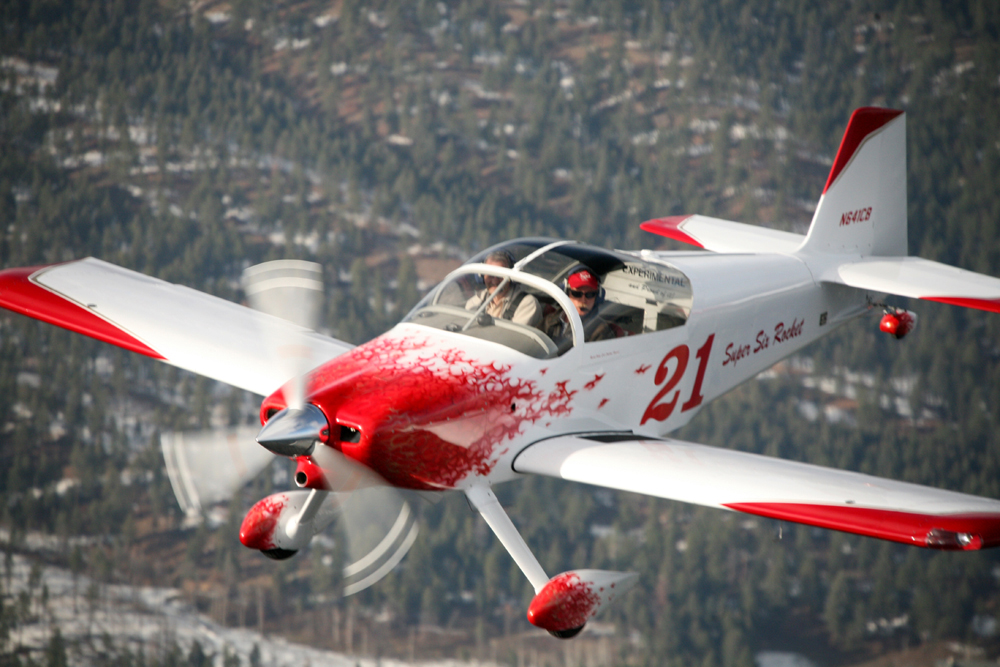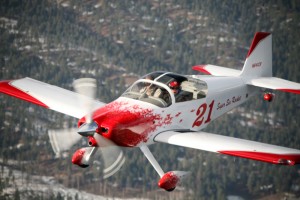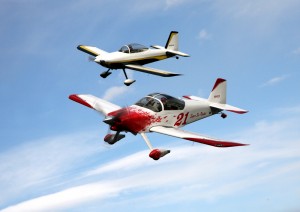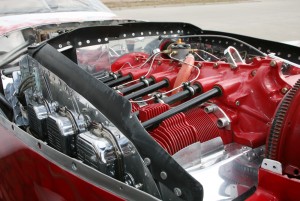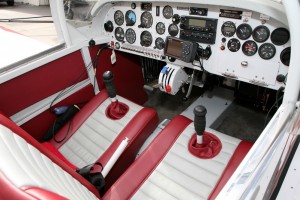By Geoff Flossic
When stepping into Carl Brownd’s hangar, you’ll find the typical items, such as caps received as gifts, photos proudly displayed and aircraft oil. Brownd is a pilot, but also has a keen eye for photography. Mounted on the loft railing is a large picture he took of Joe Thibodeau’s Race 21 P-51 Mustang, taken from John Zayac’s T-6 Race 12, against the backdrop of Mount Evans. This photo is also displayed in the Perfect Landing Restaurant at Centennial Airport. Hanging next to it is a photo of an ominous-looking shark, swimming in bright blue water. Brownd took that photo while scuba diving, when the shark was just a few feet above his head.
In the center of his hangar sits Brownd’s pride and joy, a beautifully painted RV-6 he named the Super Six Rocket. Its fuselage is white with red trim, and the cowling is deep red with gold flames hand painted in fine detail. An outline of a shark in the flames goes hand in hand with the photo centered above the airplane.
Brownd purchased his RV-6 in the spring of 2000. The Super Six Rocket is a rare taildragger with side-by-side seating. Two small people can sit in the rear of the plane when seat cushions are added, making this plane the worlds’ first four-seat RV-6.
Since the age of 7, Brownd has loved to fly. He used to fly with his dad, a former WWII aircraft sheet metal mechanic, and has been hooked ever since. He flew Pipers and Cessnas in high school and soloed in a Piper, but ran out of money before he got his license. That would come later.
Originally from Texas, Brownd moved to California, then on to Colorado in 1983.
“I got hooked on gliders when I was in Aspen in 1983,” he said. “I went for a ride, and absolutely loved it. I ended up joining the Black Forest Glider Club, near Colorado Springs. I got my commercial glider rating and used to give introductory glider rides.”
Having flown tricycle gear airplanes and gliders, Brownd wanted to do more. That’s when he decided to get his taildragger rating.
“I wanted to be a tow pilot for the glider club, so I went to Centennial Airport, joined the Aspen Flying Club and finished up my power rating,” he said. “I then started flying a Citabria with PC Flyers and also did some aerobatic training with Rene Minjares.”
Beginning with a Stearman
In 1996, after logging 100 hours of taildragger time, Brownd met Eric Baldwin, who needed a partner for his Stearman. Brownd bought into the partnership.
“I flew a lot in that plane and logged more than 100 hours in it,” Brownd said.
In 1999, the Brownds flew to EAA AirVenture Oshkosh in the Stearman.
“Barb and I flew the Stearman, and Eric flew down in a 1929 Alexander Eaglerock,” Brownd remembered. “Another guy flew with us in a 1929 Curtiss Robin. We did a little barnstorming trip. Nine hours to Oshkosh and 11 hours back. It was a great time.”
The Super Six Rocket
Although Brownd really liked taildraggers, his wife didn’t want a plane in which she’d be “stuck in the back seat.” Barbara Pedigo-Brownd got her pilot license about 25 years ago and has about 50 hours flying in the front seat of the Stearman. Brownd began looking for a side-by-side taildragger.
“I saw an ad for this plane in Trade-A-Plane,” he said. “A couple of guys in Oklahoma were selling it.”
The RV-6 was originally designed to have a four-cylinder engine. The RV-6 Rocket has a Lycoming IO-540 six-cylinder engine. Brownd’s airplane is the first RV-6 to have a stretched fuselage.
“It was stretched by 14 inches in the back and six inches in the front,” he said. “The extra length in back is for center of gravity. If I don’t have anyone in the back, I can put up to 150 pounds of baggage there. My wife and I can throw the bags in, put about four hours of fuel in it, and get up and go.”
Brownd’s Super Six Rocket resembles John Harmon’s Harmon Rocket. Harmon took an RV-4, lengthened the fuselage and replaced the engine with a more powerful one, thus making it a “rocket.”
After Brownd bought his plane, he put a new Hartzell three-bladed “Scimitar” propeller on it and had the engine rebuilt. He added several high-performance features to get an estimated 299 hp. He spent six years renovating the plane, including redoing the injection and adding ram air. He added a special filter to get ram air injection to the engine, for extra horsepower.
He reshaped the engine cowling and added smaller tires and custom wheel pants, and replaced the gear leg fairings and tail fairing for less drag. He even changed the wingtips.
“They’re called ‘hot tips.’ They’re flared, rather than straight, and have a different air flow contour,” Brownd said. “Harmon said that gave him about seven miles an hour. I think that it gave me about two or three. That was a lot of work for three miles an hour.”
The AirVenture Cup
Brownd became interested in racing after getting acquainted with several guys who race at Reno. He also read about an Experimental Aircraft Association-sponsored, cross-country race that started in Kitty Hawk, N.C., went to Dayton, Ohio, and then on to Oshkosh, Wis.
“My initial goal was to get the plane repainted and rebuilt in time to do that race,” Brownd said.
But problems hampered him from the beginning.
“I would get it up flying and then find something I wanted to change,” Brownd said. “Then I’d get it flying again and would find another problem. I’d have to take it apart and start over.
Brownd set a new goal to have the plane ready for the 2006 race. This 425-mile race started in Dayton, at Dayton-Wright Brothers Airport (MGY) and finished at a private air strip near Fond du Lac County Airport (FLS).
Brownd went full bore into the work on his plane, from December to July.
“I was out here five days a week, evenings and weekends,” he said.
He wasn’t alone. He had assistance from several people who wanted to help make his dream a reality.
“Jeff Michael did a lot of the fiberglass work and taught me about it,” Brownd said. “Craig Haakenson (an airline mechanic) and a couple of Arapahoe Aero mechanics helped out. So did Ryan Bendeur, a United Airlines mechanic, who built his own RV. It was kind of ‘learn as you go.’ I could probably pass my A&P license without to much trouble with all I’ve learned over the last six years.”
In April 2006, Brownd finally had his plane ready to take to Texas to get it painted. When he returned, he found the paint job wasn’t quite right, so he flew it back down to have it repainted.
“I picked it up in Dallas ten days before we were scheduled to leave for the race,” he said. “The paint was barely dry.”
The Brownds packed up and flew to Dayton for the AirVenture Cup Air Race, held on July 23. Race founders wanted to keep the cross-country racing traditions alive, reminiscent of the races of the 1930s and 1940s. Sixty participants made up 10 classes, designated by cubic inches and the type of landing gear. Brownd was initially entered in the sport class, competing against Lancairs and Glasairs.
“I emailed a few people and told them it wasn’t fair to pair me up with planes like that. They added the FX class, which supported fixed gear planes with 540 cubic inch engines,” Brownd said.
In this timed cross-country race, pilots don’t fly around pylons like at Reno; they fly from point to point. The one-day event starts the morning before AirVenture and ends a few hours later. A timer is located at the end of the takeoff runway, and it starts when a pilot crosses that point. The pilot must cross two turn points along the route, and then head to the finish line, making a low approach across an orange line that marks the end time.
“The guy behind me was only 33 seconds behind, over a 420-mile course, and the next guy was a minute and a half behind,” Brownd said. “I couldn’t believe how close we were after two hours and 10 minutes of flying.”
The race course started in Ohio and crossed Indiana. Sterling Rock Falls, Ill., was the first turn point. Rockford, Ill., was the second turn point, and the finish line was at a private strip near Fond du Lac County Airport. Each turn point was at a small airstrip, where a spotter was stationed next to the runway.
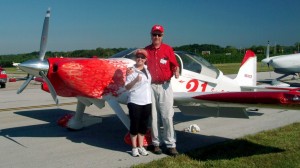
Carl and Barbara Brownd are ready to start the 2006 AirVenture Cup. The couple finished second in the EAA-sponsored cross-country race that started at Dayton-Wright Brothers Airport and finished at a private air strip near Fond du Lac County Airport.
“You had to make a low approach down the runway, find the guy in the pickup and then fly across a certain point on that airport,” Brownd said. “That was your turn point.”
At one point in the race, Brownd noticed a fixed-gear Glasair creeping up on him. After about 25 miles, it slowly slipped by. He remembered a few people telling him that if he needed more power and more speed, he should get down to a lower altitude.
“My wife and I were at about 1,500 feet and dropped down lower,” he said.
Going down to a lower altitude paid off. Brownd started to catch up with the Glasair and finally caught him at the second turn point.
“We were at the second turn point, getting ready to head towards the finish line,” Brownd said. “I was thinking, ‘I’m never going to pass him, but I’m going to see what I can do.'”
About that time, the Glasair pulled up and out of the race. The Glasair had broken an exhaust manifold, and that allowed Brownd to finish second, instead of third, with an average speed of 221.8 mph. Brownd didn’t know about the second-place finish until later that night, during the dinner ceremony.
“I thought I had finished third; after crossing the finish line, I climbed out and did a victory barrel roll,” he said. “We got back to the airport and landed. The guy who finished behind me had already landed. I hadn’t thought about the time it took to go off and do the roll, so I thought, “Man, after all that, I finished third.'”
Later that day, all the racers flew into Oshkosh for AirVenture as a flight of 60 and were parked in the front row. Several people asked Brownd about his airplane, including the editor of Sport Aviation, who is doing a feature article on the Super Six Rocket set for publication in May 2007. Brownd was elated. This was a finish that exceeded all expectation.
“I just wanted to race,” he said. “I didn’t care if I came in last place. I just wanted to get in the race, finish safely and bring home a t-shirt.”
For more information about the AirVenture Cup, visit www.airventurecup.com. For information about RV airplanes, visit [http://www.vansaircraft.com].











